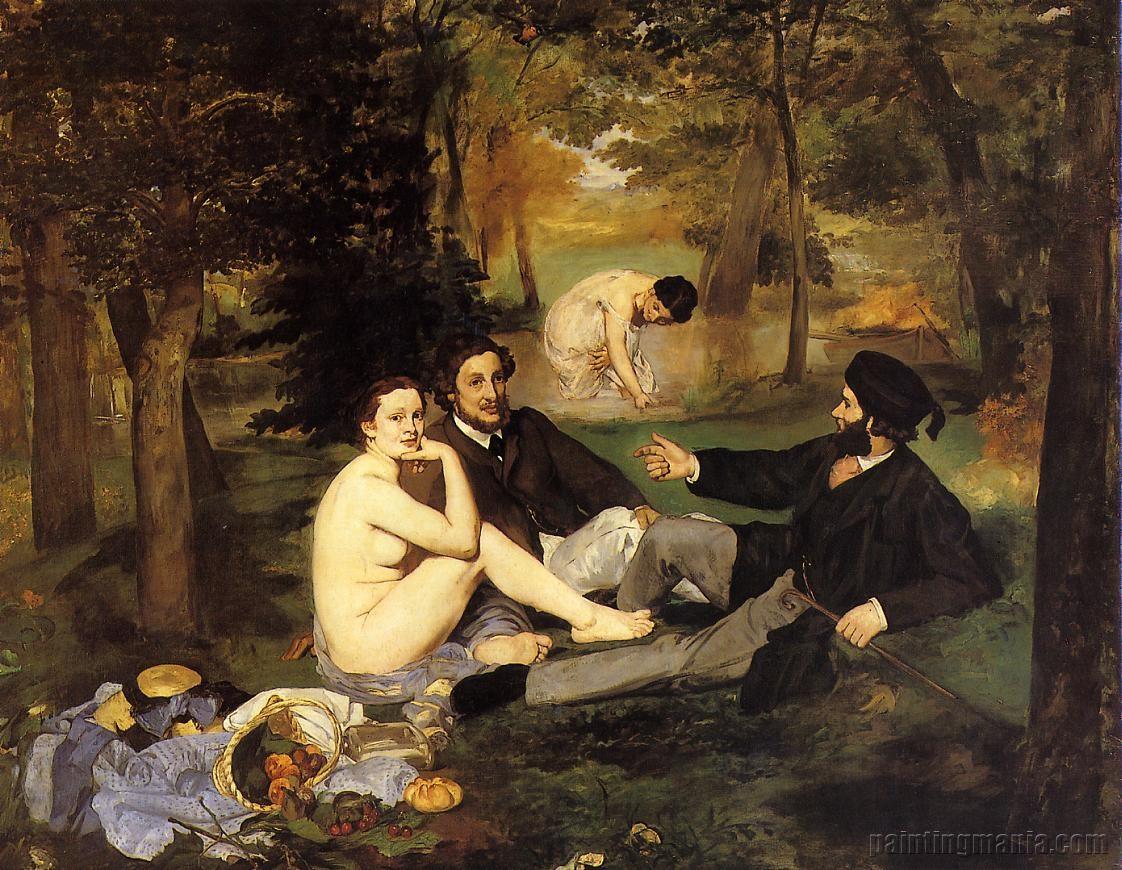empathy
About male vulnerability and gender equality for nudes

Edouard Manet, Le Dejeuner Sur L'herbe
Art critic John Berger really hit the nail on the head when he said, referring to the depictions of female bodies in Western art, “Men look at women. Women watch themselves being looked at.” This idea is illustrated in a clever and intriguing way in Edouard Manet’s 1863 work, Le Déjuner sur l’Hèrbe (“Luncheon on the Grass”) now hanging in the Musée d’Orsay, which depicts a nude woman seated alongside two fully-clothed men. The woman is Victorine Meurent, Manet’s favourite model, who is also depicted in Olympia, a work that reinterprets Renaissance-style nudes. In “Luncheon on the Grass,” the two men seem to be deep in conversation, completely ignoring the nude at their side. It’s almost as if they are taking her presence – and her nudity – for granted. As for Victorine herself, she breaks the fourth wall by looking directly at the viewer who looks at her. The expression in her eyes is that of a woman aware of the fact that she is there to be looked at. However, she seems to have an ironic and challenging attitude towards the situation.
The reversed scenario, which would be a fully-clothed woman in the company of nude men, is rarely seen. The one who is clothed has the power and the luxury to have their body sheltered from prying eyes, while the nude one may be comfortable with it, but is still exposed and vulnerable. The idea of men being depicted as relinquishing power and embracing vulnerability is still mildly amusing at best. At worst, it causes anger. Many men are not comfortable with the idea of the female gaze, which would imply that they become the ones being looked at and desired. But the denial of male vulnerability is a lie. As all lies, it can be quite damaging to one’s psyche and sense of individuality and identity.
Popular art forms are still wary to depict the male form and, when they do, they portray only the dominant side of it. The hit TV series “Game of Thrones” depicts some male nudity – though it doesn’t balance out the disproportionate amounts of female nudity – but the men, even when naked, are still not portrayed as vulnerable, but assertive and aggressive. This is, of course, in accordance with the fictional world depicted, a world of strict gender roles in which mutuality has no place.
RECOMMENDED READING: IF YOU’RE INTO MORE CLASSIC NUDITY, YOU MAY WANT TO CHECK HOW ART AFFECTS BODY IMAGE
In real life, the aggressive type of male nudity takes the especially nasty form of unsolicited dick pics. And here I would like to take a minute to say – DON’T. No one wants that. No one. There is only one thing unsolicited dick pics can achieve and that is to make sure that the recipient does not want anything at all to do with you, ever.
Back to the topic at hand, it’s very rare to come across art that depicts male nudity as vulnerable. Elegant – yes. Powerful – almost always. Classical art has given us the concept of heroic nudity – the Ares Borghese still looks ready for battle, even completely exposed (to be fair, he *is* wearing a helmet). Apollo can still defeat the serpent Python with nothing but a cloak (and a fig leaf) on. Of classical influence, Michelangelo’s “Dying Slave,” with his attitude of abandonment, is a rare example of vulnerable male nudity but, the thing is – he’s dying! Surely, men are allowed moments of vulnerability before that.
Even nowadays, male vulnerability remains taboo. Let’s not forget that art is a reflection of life. Men are largely still expected to be strong, emotionally distant, boisterous, dominant and aggressive, and male vulnerability is equated with weakness and with failure to live up to “real man” standards. Features such as long, slim fingers are considered unmanly, because a man is “supposed” to have large, calloused hands, but long, slim fingers can play a piano and enrapture the whole world. A brooding, stony expression is considered most desirable, but a smile or a tear have the power to bring people together. Most artistic depictions shy away from these things.
Besides the largely unexplored aesthetic potential of its artistic depiction, male vulnerability can have an even greater power of seduction than aggression and dominance, because vulnerability implies trust and mutuality.
Last year, the Gothic Romance pastiche extravaganza (not that there’s anything wrong with pastiche or extravaganza) movie “Crimson Peak” featured a sex scene where actor Tom Hiddleston was partially exposed, while no part of his co-star Mia Wasikowska’s body was visible. The scene was well appreciated, but, as the French say, Honni soit qui mal y pense. It was a rare instance of cinematic sex that depicted mutuality and abandonment, as opposed to the usual predator-prey, dominator-dominated scenario.
Perhaps the general mentality is, indeed, slowly changing. In the end, vulnerability is not “feminine.” It is human. It needs to be accepted in men and no longer taken for granted in women. When it comes to human nature, there is simply no such thing as a given, because human beings are way too complex, and no one can be one thing only at all times. We have moments when we are powerful, and we have moments when we are vulnerable. Far from being something to be ashamed of, it is something to be celebrated.
—
Anca Rotar is a Romanian-born writer, over-thinker and caffeine addict. She is the author of two books, Hidden Animals and Before It Sets You Free, both available from Amazon.com. Among her interests, which she finds it hard to shut up about, she counts fashion, yoga, city breaks and deadpan sarcasm. She is also currently studying Japanese, so wish her luck. You can sample bits of Anca’s creative writing here.
Be the first to write a comment.
Your feedback
